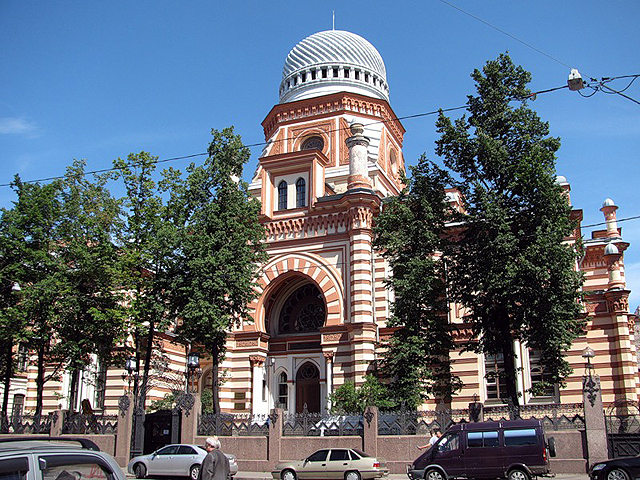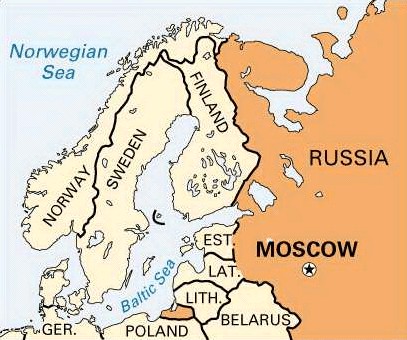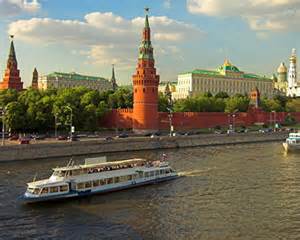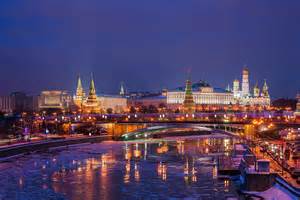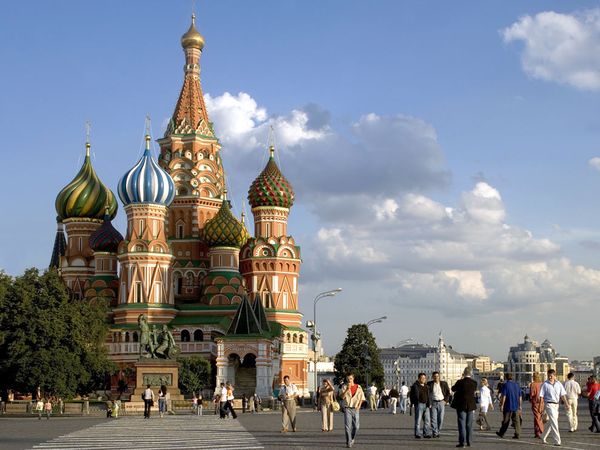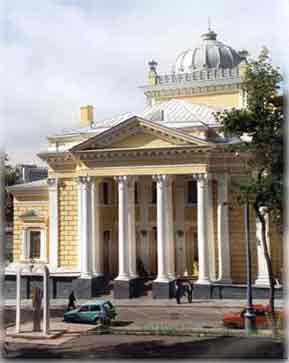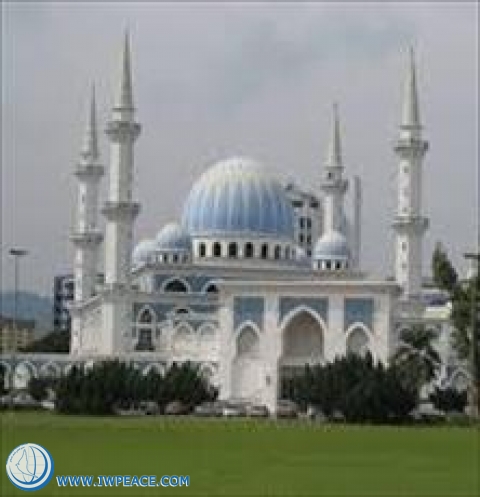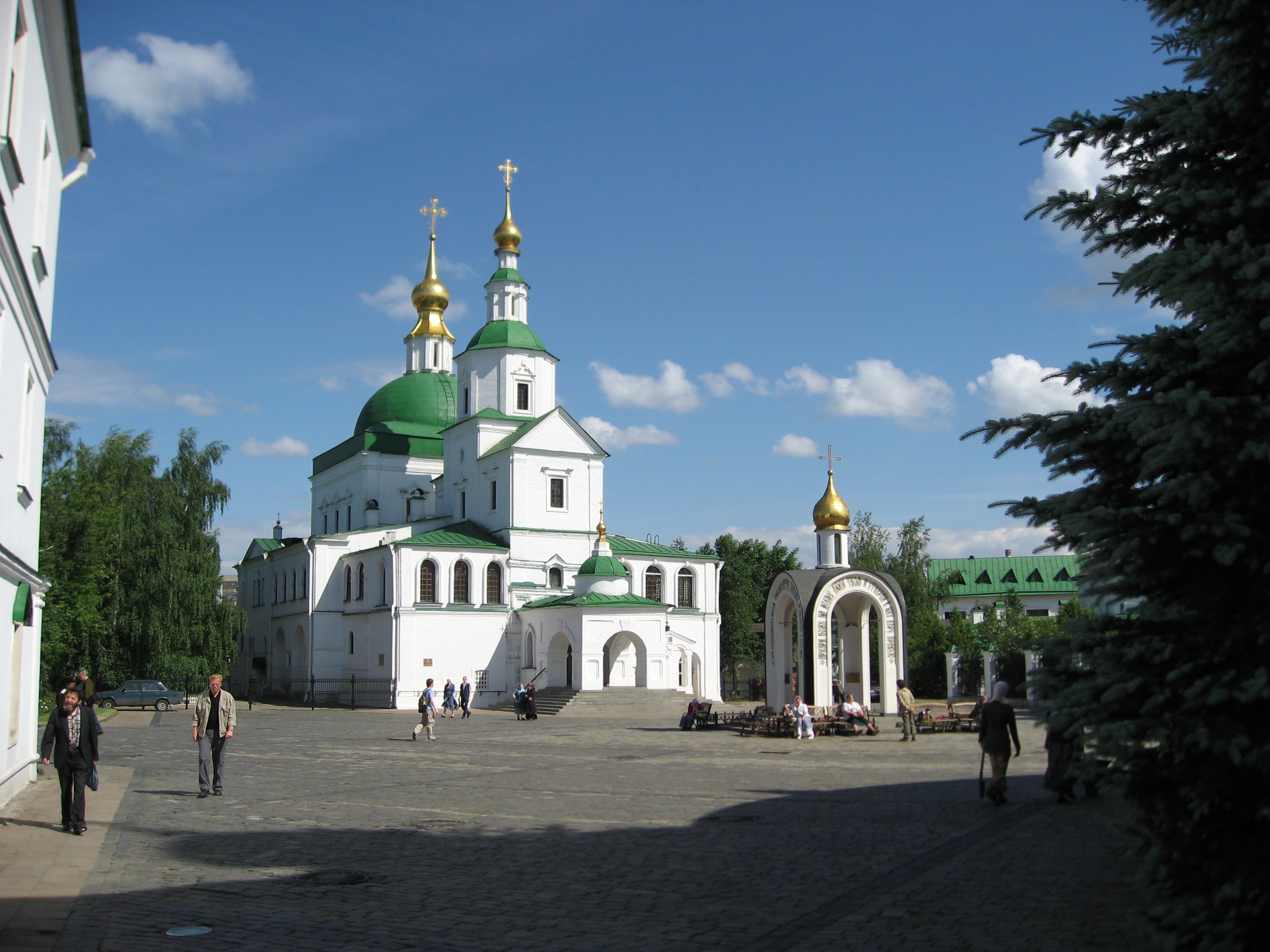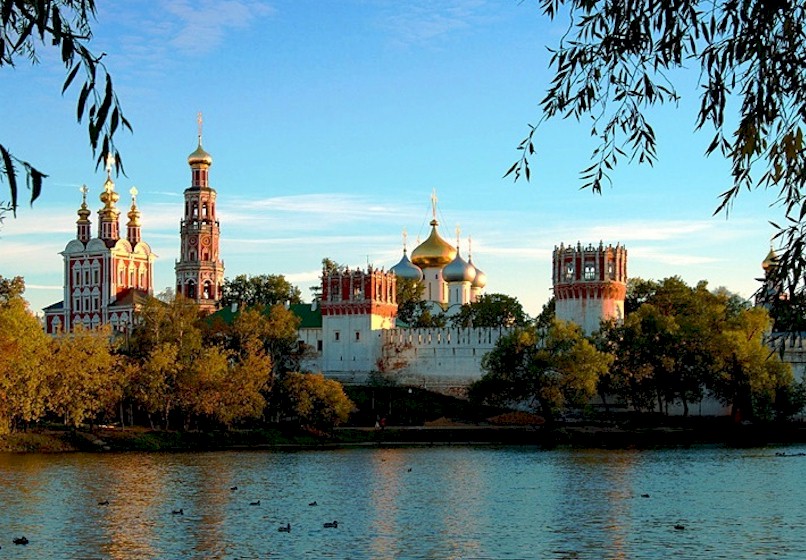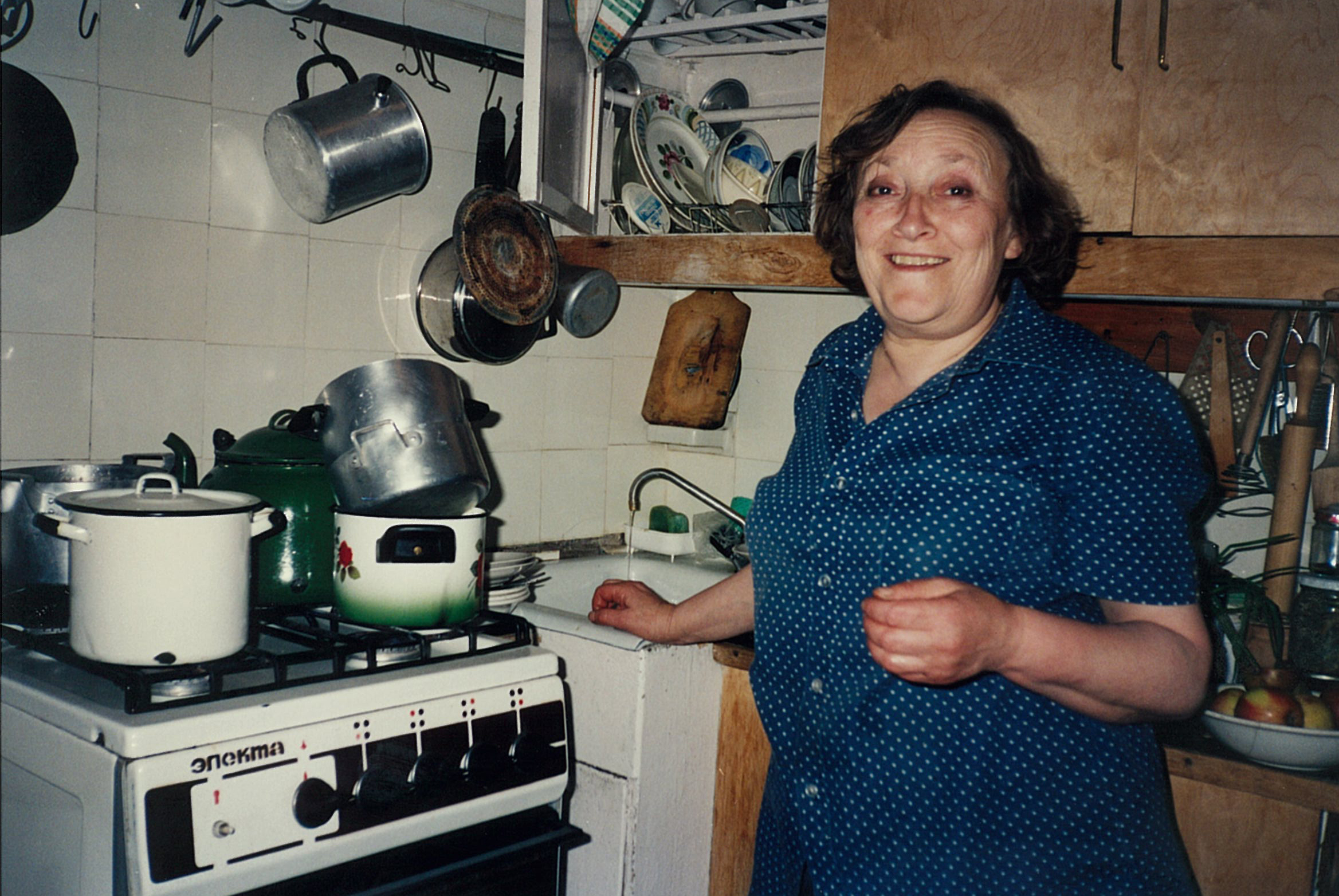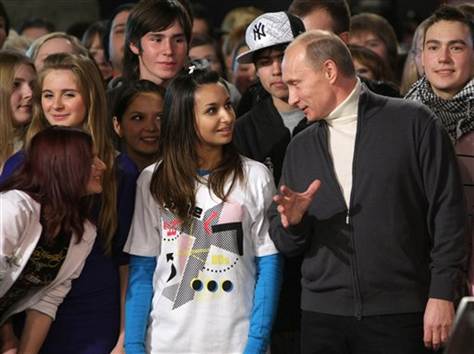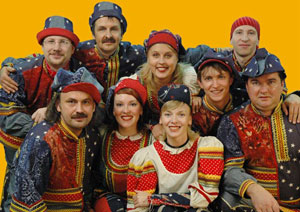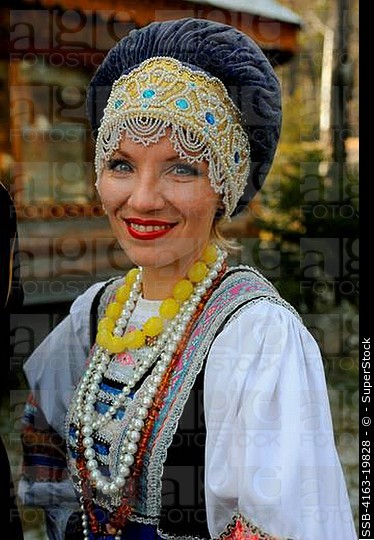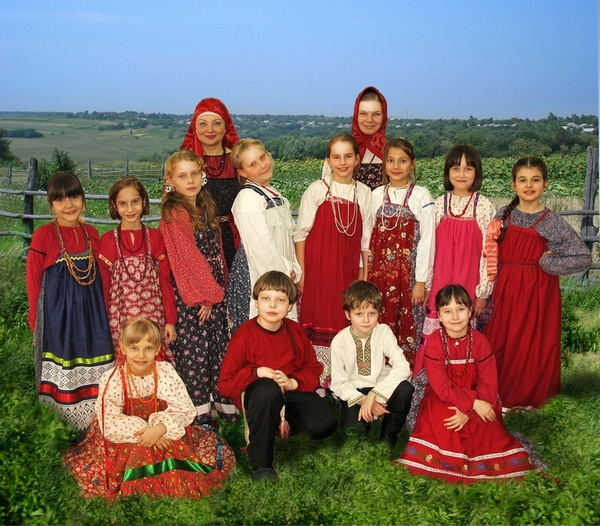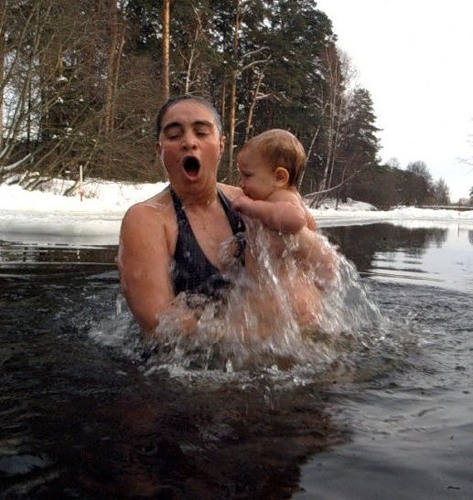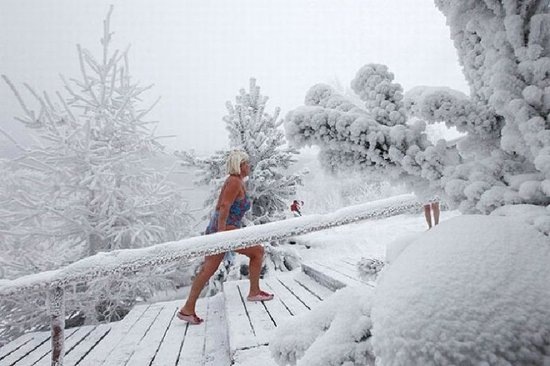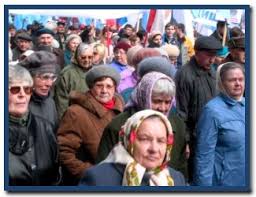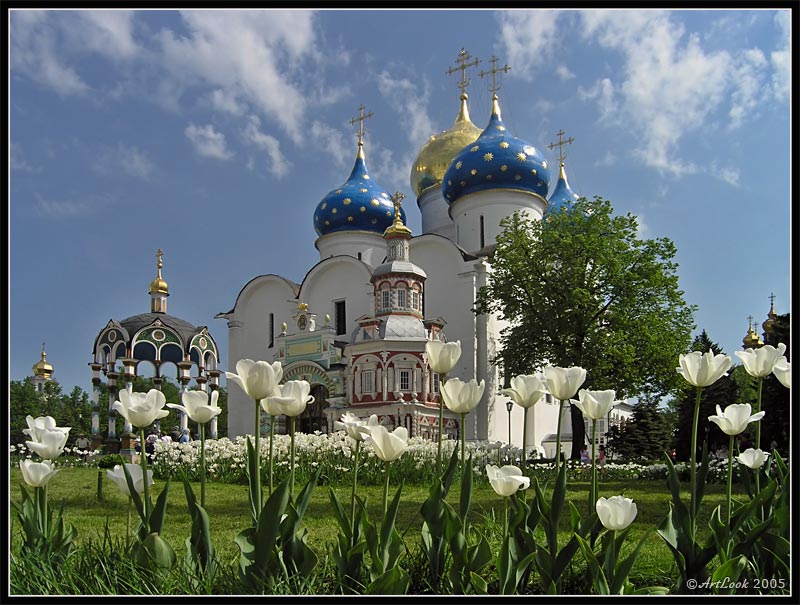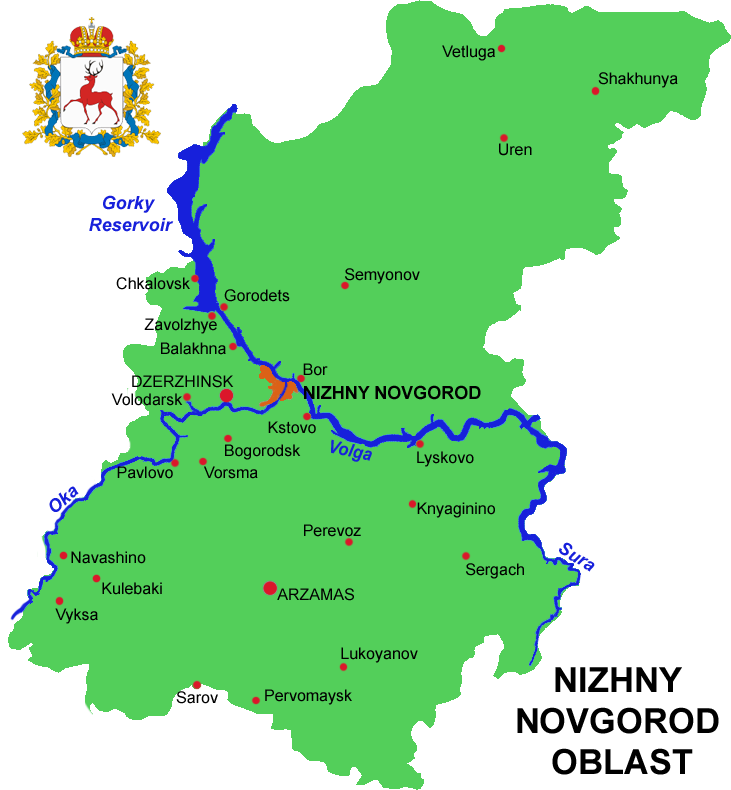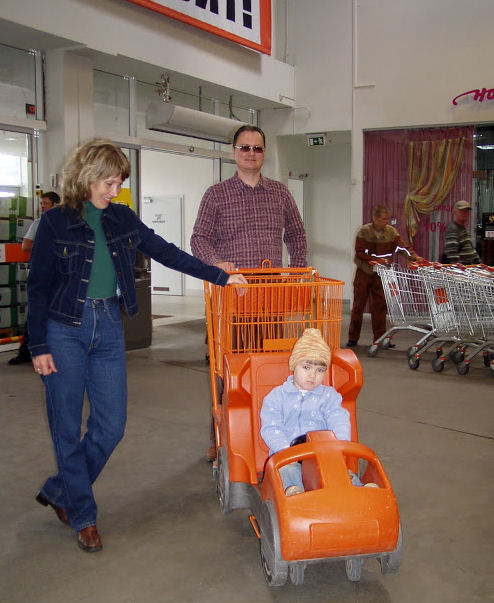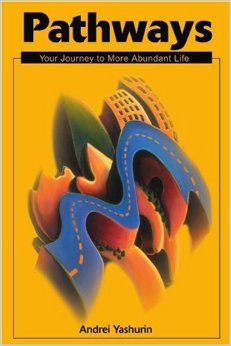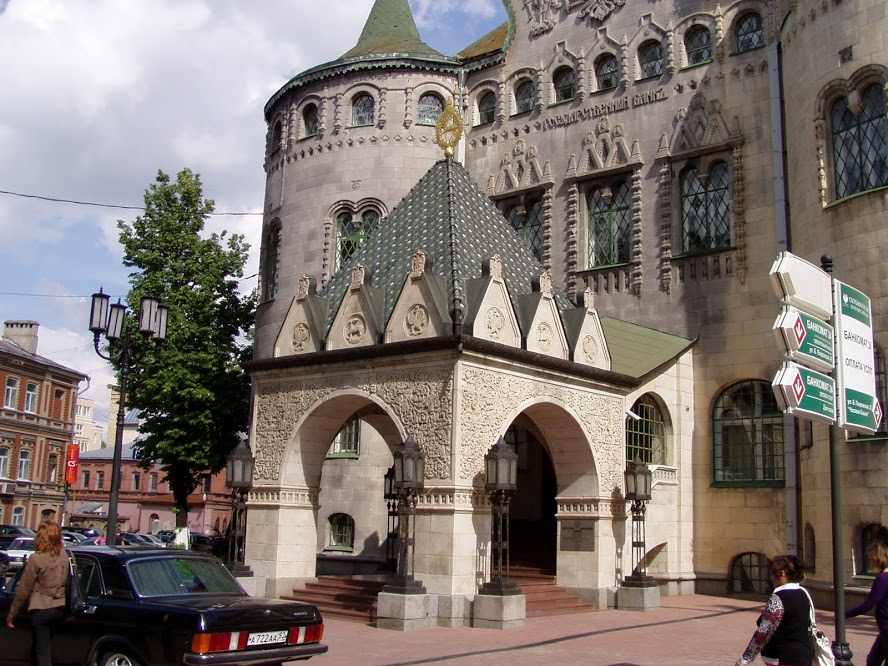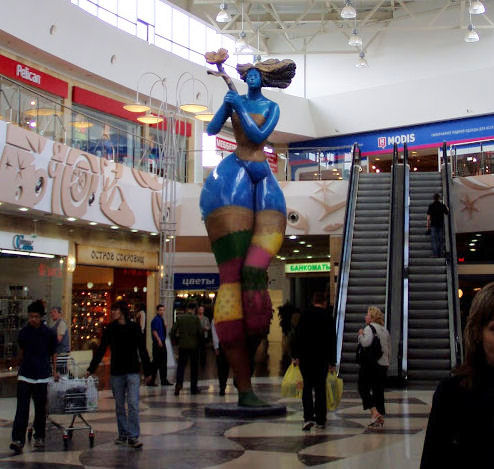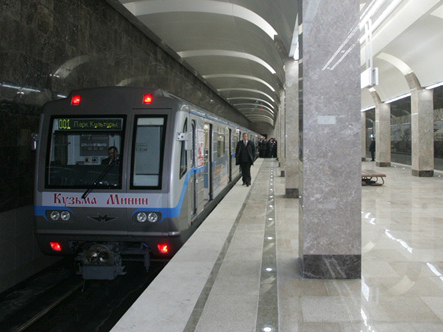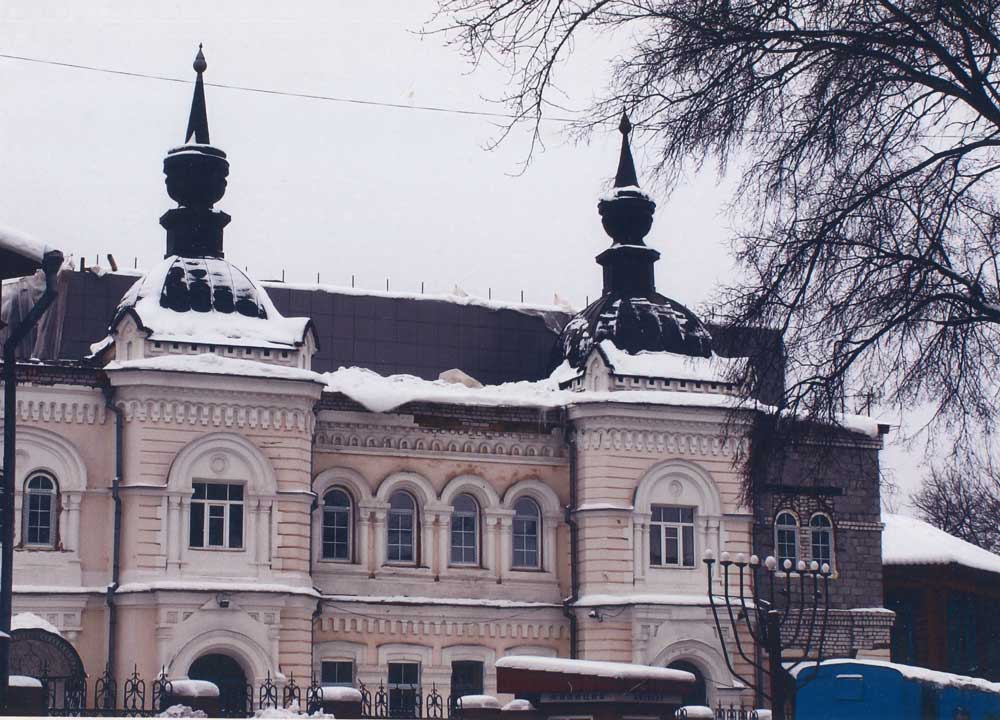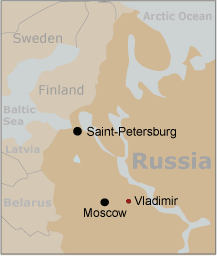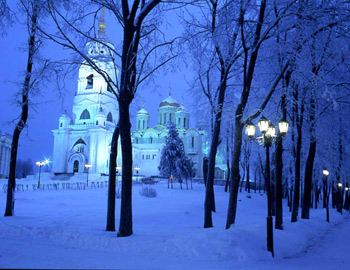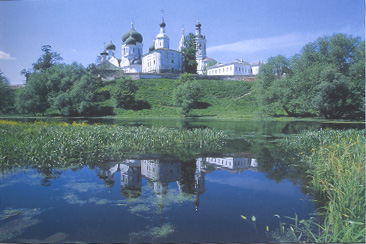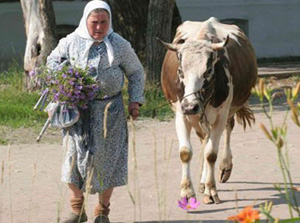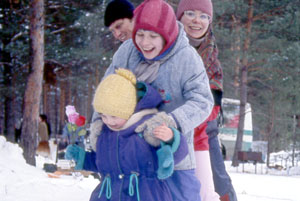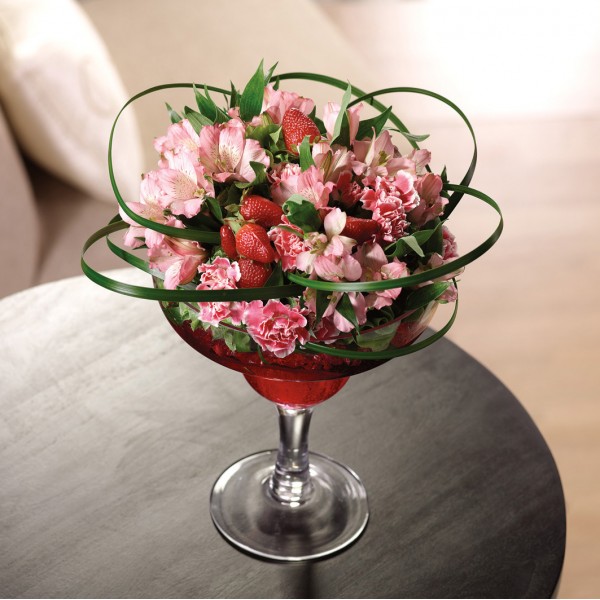GETTING TO KNOW THE BEAUTY OF RUSSIA & ITS PEOPLE – A PICTORIAL/PROSE DOCUMENT
GETTING TO KNOW THE BEAUTY OF RUSSIA & ITS PEOPLE
Nancy, with Twin Flame Uriel
You and I are presently experiencing just one brief lifetime within the total span of our ETERNAL SELF. For Phyllis, others among my friends, and I a beloved portion of our ETERNAL SELF was spent as a Russian. The love we feel for Russia and its people is palpable.
SOMEWHERE IN TIME
Phyllis Min, IHH Program Coordinator
October 1991
“Does my heart hang down low?
Should I cry when they go?
How can I say what I feel,
For the longing does not speak a word.
Grieve me not for this I know, that …
Come tomorrow, I will be whole.”
While listening to the background music playing of “Somewhere In Time,” I am directed to take up my pen and attempt to put into words what I am feeling. It is about the Russian experience, an experience of living with and loving six individuals who came to the IHH [Institute of Higher Healing] from another culture, language, and land. I can only state, “How beautiful they are and how deep my compassion has been.” For being in the mere presence of the Russians was intriguing, mystifying, and yet a sacred encounter.
I have found my new friends, Vladimir, Natasha, Nicolay, Alexander, Alla and Sergei, to be all—plus more—of what I had already imagined. While dutifully performing all the mundane preparations for the 1991 Conference, a part of me seemed locked in a trance of an energy field of only the “names” of the visitors yet to come. However, somewhat imbued by all, I knew that a new beginning was about to occur. Even now I do not know what this fully means, but I do recognize that something unlocked within me, so divine and yet so filled with passion, in reaching out to these six individuals. When not in physical presence, my heart strings were seemingly connected to them by golden threads, linked in pink and pure white light, that told me “somewhere in time” we have met before. Is it that we are all one—that we all can recognize the inner essence of divine light—all so beautiful and loving? Are we not from the same Source and now only to be reminded in this dream form? I ask myself again what do I feel? A truer answer simply replied, “The lingering on of a profound love residing very deep within.”
To say I love you in English they may have heard, but our dear visitors felt it. They felt loved not only by me (as I felt like a constant vibrating beacon of love), but from the numerous encounters they had from the Conference and friends of the IHH. I feel like I am waiting somewhere in time and finding a new purpose or direction. A beginning of a real power of love and light demonstrating that there is no distance or miles between souls.
With conviction about this love affair with our guests, I extend this love to all humankind and lifeforms, and welcome everyone to join me. For the days ahead we shall share great bondage, memories and links with our brothers and sisters everywhere. As I propose an international fanfare for our next conference, I am reminded that what lies before us is a grand journey where there will be no separation of miles or language, only the instant recall we are all here now together in this time and space to share love.
******
As a result of this IHH Conference in Richmond, Virginia, Phyllis has visited Russia 5 times. We will hear more of her journey later in this document.
GETTING TO KNOW THE BEAUTY OF RUSSIA & ITS PEOPLE
RUSSIA IS THE LARGEST COUNTRY IN THE WORLD
“Covering an expanse of over 6.6 million square miles, Russia is the world’s largest country by landmass, beating out runner-up Canada by around 2.8 million square miles. It includes nine different time zones and shares land borders with 14 neighboring countries. Russia’s origins began with the Viking establishment of Kievan Rus in the 9th century. It expanded under the leadership of Viking chieftain Rurik and his ancestors but was broken up by Mongol invaders in 1237. Beginning with the Grand Duchy of Moscow, which was less vulnerable to Mongol attacks due to its remote, forested location, the remnants of Rus unified and expanded, most notably during the reign of Ivan the Terrible from 1533 to 1584. As its first official tsar, Ivan established the central Russian state and doubled its size by conquering the regions of Kazan, Astrakhan and Siberia. It expanded into the third largest empire in the world by the 1700s, and as the post-revolution Russian Soviet Federative Socialist Republic, it was the largest part of the Soviet Union. With the break-up of the Soviet Union, Russia, also known as the Russian Federation, was officially established on December 25, 1991.”
http://www.history.com/news/ask-history/what-is-the-largest-country-in-the-world
RUSSIA IS RULED BY URANUS & AQUARIUS
URANUS is the planet of Innovation, Intuition, & Scientific Studies – Electric Blue is its color. As you view the photos of Russia, note how often a bluish hue fills the air and how many of the buildings highlight the color of blue in their structure. A sky blue is the color of devotion.
AQUARIUS’s symbol is the Waterbearer to Humanity—the energy of Sister/Brotherhood. Decades ago, the world renown medical intuitive, Edgar Cayce, predicted of Russia: “Through Russia,” Cayce said, “Not in respect to what is sometimes termed Communism or Bolshevism — no! But comes the hope of the world freedom — freedom! That each man will live for his fellow man. The principle has been born there. It will take years for it to be crystallized; yet out of Russia comes again the hope of the world.”
According to Lada Ray
http://futuristrendcast.wordpress.com/
Lake Baikal is justifiably known as the jewel of Siberia. This crescent-shaped, 395 mile (636 km) long body of water – pure enough to drink and filling one of the deepest gashes in the earth’s surface – is hemmed in by mountains and forests teeming with wildlife.
http://huffingtonpost.triporati.com/guides/Europe/Russia/Lake+Baikal/region
Russian South boasts pleasant sub-tropical climate with hot summers and luxurious landscapes – along the Black Sea.
http://lingfeastics.com/russia-the-beautiful-southern-nature/
“In the name of God, stop a moment, cease your work, look around you.”
HISTORICAL SUMMARY OF RUSSIA
“Russia was for many centuries separated, geographically and politically, from the development of Western civilization and culture, and thus came late into what, for most of Europe, would be called the modern age. But the eighteenth and nineteenth centuries, witnessing as they did an extensive overcoming of these earlier barriers, permitted a very considerable progress in the modernization of Russian society. By the time the country was overtaken by the First World War, its situation was not entirely discouraging. Industrialization was proceeding at a level only two or three decades behind that of the United States. There was under implementation a program of education reform which, if allowed to continue unimpeded, would have assured total literacy within another two decades.
And the first really promising program for the modernization of Russian agriculture (the so-called Stolypin reforms), while by no means yet completed, was proceeding steadily and with good chances for ultimate success.
These achievements, of course, had not been reached without conflicts and setbacks. Nor were they, alone, all that was needed. Still to be overcome as the war interceded were many archaic features in the system of government, among them the absolutism of the crown, the absence of any proper parliamentary institutions and the inordinate powers of the secret police. Still to be overcome, too, was the problem of the non-Russian nationalities within the Russian Empire. This empire, like other multinational and multilingual political constellations, was rapidly becoming an anachronism; the maintenance of it was beginning to come under considerable pressure.
But none of these problems required a bloody revolution for their solution. The removal of the autocracy was, after all, destined to be achieved relatively bloodlessly, and the foundations of a proper parliamentary system laid, in the first months of 1917. And there was no reason to despair of the possibility that Russia, if allowed to develop without war or violent revolution, might still encompass a successful and reasonably peaceful advance into the modern age. It was, however, just this situation, and just these expectations, that were to be shattered by the events of the final months in that fateful year of 1917.
The Russian oppositional movement of the last half of the nineteenth century and the first years of the twentieth had always included extreme radical factions that did not want reform to proceed gradually, peacefully and successfully. They wanted nothing less than the immediate and total destruction of tsarist power and of the social order in which it operated. The fact that their own ideas of what might follow upon that destruction were vague, unformed and largely utopian was not allowed to moderate the violence of their intentions. Participating, though in quite different ways, in both of the major revolutionary parties, the Socialist Revolutionaries and the Social Democrats (out of whom the Communists emerged), these factions found themselves, in their bitter opposition to gradual reform, in a state of limited and involuntary alliance with the most radical reactionary circles at the conservative end of the political spectrum. After all, these latter also did not want to see change proceed gradually and peacefully, for they did not want it to occur at all. So it was not by accident that the ideas and aims of both extremist elements were to find a common expression, as Robert C. Tucker has so persuasively pointed out in his recent work, in the Stalin of the future.”
[Russia was ruled by Communists from 1917 to 1991.]
“The post-communist Russia we now have before us finds itself not only confronted with, but heavily involved in, the Herculean effort to carry out three fundamental changes in the national life of the country.
The first of these changes is the shift of the vital center of political power from the Communist Party, which has had a monopoly on power for so many years, to an elected and basically democratic governmental structure. The second is the shift of the economy from the highly centralized and authoritarian administrative basis that has governed it since the 1920s to a decentralized free-enterprise system. The third is the decentralization of the structure of interrelationships among the various national components, originally of the tsarist empire and more recently of the Soviet Union, that has generally prevailed over the last three centuries.
These three changes, if successfully implemented, would represent in many respects an alteration of the life of the Russian state more fundamental than that which the communists endeavored to introduce into Russian life in 1917-more fundamental, because whereas the communists’ changes purported, rather vaingloriously, to deny, ignore and consign to oblivion the Russian past, the present efforts at change are linked, consciously or otherwise, to that past, and reflect an inclination not only to respect but in part to resume the struggles for modernization that marked the final decades of tsardom. If successfully carried through, these changes would constitute the greatest watershed in Russian life since the Petrine reforms of the early 18th century.”
http://www.foreignaffairs.com/articles/46266/george-f-kennan/communism-in-russian-history
Keep in mind that the above history was written from the point of view of an American, not a Russian.
A post communist nation—the Russian Federation—is now a federal presidential republic, with a democratically elected president. The above historical summary allows us to perceive the mammoth job Vladimer Putin assumed when he agreed to be Prime Minister in 1999. 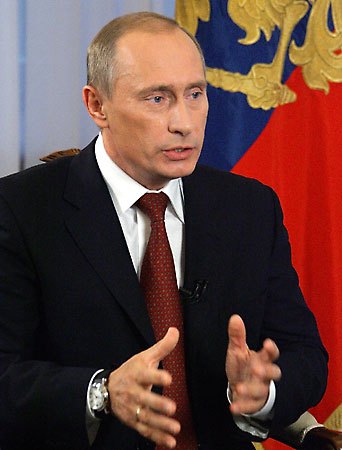
Putin’s career rise was rapid…. In August 1999—8 years after the end of Communist rule—Putin was appointed Prime Minister of the Russian Government. The post was offered to him by then President Boris Yeltsin.
As Putin later recalled, “Mr Yeltsin invited me to come and see him and said that he wanted to offer me the prime minister’s job. <…> Incidentally, he never used the word ‘successor’ in his conversation with me then, but spoke of becoming ‘prime minister with prospects’, and said that if all went well, he thought this could be possible”.
Putin described his time in the prime minister’s office as an honour and an interesting experience. “I thought then, if I can get through a year that will already be a good start. If I can do something to help save Russia from falling apart then this would be something to be proud of.” (http://eng.putin.kremlin.ru/bio)
St. Petersburg, Russia – President Putin’s birthplace
The second largest city in Russia
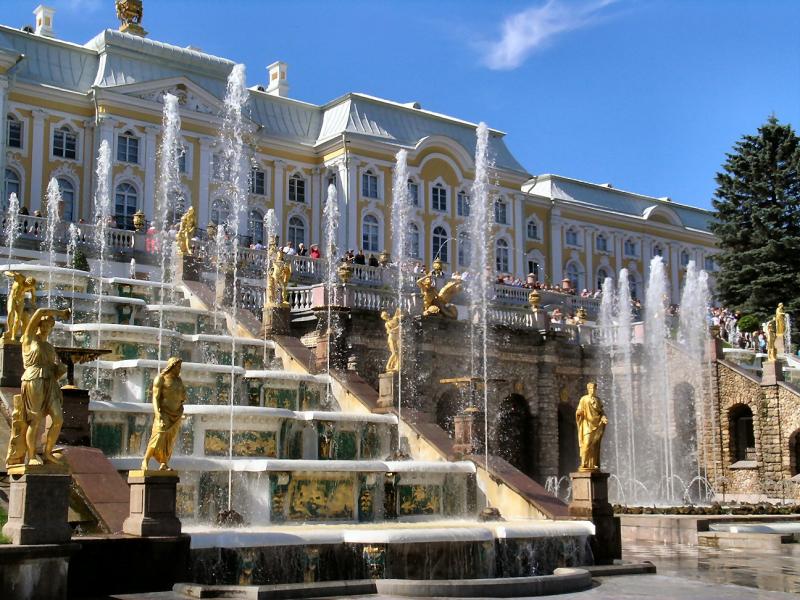 Grand Peterhof Palace and the Grand Cascade
Grand Peterhof Palace and the Grand Cascade
POWERPOINT
This powerpoint reveals the grandeur of historic Russia.
http://pathwaytoascension.wordpress.com/2014/10/03/powerpoint-of-st-petersburg-russia/
Winter Palace, St. Petersburg
St. Petersburg Mosque
When opened in 1913, was the largest mosque in Russia, its minarets 49 meters in height and the dome is 39 meters high. The mosque is situated in downtown St Petersburg. It can accommodate up to five thousand worshippers. The Mosque was closed to worshippers from 1940 to 1956.The St. Petersburg Mosque was closed and was made into a warehouse during the Second World War. At the request of the people the mosque was returned to the Muslim community of the city in 1956. A major restoration of the mosque was carried out in 1980.
http://baltiyahotel.ru/mosque.html
CHRISTIANITY MADE THE STATE RELIGION IN 988.
Christianity was first introduced to Russia from Byzantium (Greek Orthodox) between 860 and 867. At this time Kiev — south of the Chernobyl site — was the capital of Russia. In 957 the regent Olga was baptised in Constantinople; her grandson Vladimir made Christianity the state religion in 988.
https://www.vulcanhammer.org/2009/06/21/visit-to-zagorsk/
RELIGION IN RUSSIA DURING THE COMMUNIST ERA
“The Soviet Union was the first state to have as an ideological objective the elimination of religion. Toward that end, the Communist regime confiscated church property, ridiculed religion, harassed believers, and propagated atheism in the schools. Actions toward particular religions, however, were determined by State interests, and most organized religions were never outlawed.
The main target of the anti-religious campaign in the 1920s and 1930s was the Russian Orthodox Church, which had the largest number of faithful. Nearly all of its clergy, and many of its believers, were shot or sent to labor camps. Theological schools were closed, and church publications were prohibited. By 1939 only about 500 of over 50,000 churches remained open.
After Nazi Germany’s attack on the Soviet Union in 1941, Joseph Stalin—who studied for five years to be a priest, but never became one—revived the Russian Orthodox Church to intensify patriotic support for the war effort. By 1957 about 22,000 Russian Orthodox churches had become active. But in 1959 Nikita Khrushchev initiated his own campaign against the Russian Orthodox Church and forced the closure of about 12,000 churches. By 1985 fewer than 7,000 churches remained active. Members of the church hierarchy were jailed or forced out, their places taken by docile clergy, many of whom had ties with the KGB.
Campaigns against other religions were closely associated with particular nationalities, especially if they recognized a foreign religious authority such as the Pope. By 1926, the Roman Catholic Church had no bishops left in the Soviet Union, and by 1941 only two of the almost 1,200 churches that had existed in 1917, mostly in Lithuania, were still active. The Ukrainian Catholic Church (Uniate), linked with Ukrainian nationalism, was forcibly subordinated in 1946 to the Russian Orthodox Church, and the Autocephalous Orthodox Churches of Belorussia and Ukraine were suppressed twice, in the late 1920s and again in 1944.
Attacks on Judaism were endemic throughout the Soviet period, and the organized practice of Judaism became almost impossible. Protestant denominations and other sects were also persecuted. The All-Union Council of Evangelical Christian Baptists, established by the government in 1944, typically was forced to confine its activities to the narrow act of worship and denied most opportunities for religious teaching and publication. Fearful of a pan-Islamic movement, the Soviet regime systematically suppressed Islam by force, until 1941. The Nazi invasion of the Soviet Union that year led the government to adopt a policy of official toleration of Islam while actively encouraging atheism among Muslims”
http://www.loc.gov/exhibits/archives/anti.html
Akhmad Kadyrov Mosque – located in Grozny, the capital of Chechnya.
It is one of the largest mosques in Russia and is officially known as the The Heart of Chechnya.
http://forum.xcitefun.net/akhmad-kadyrov-mosque-russia-images-t83798.html
Chechnya Republic is a federal subject of the Russian Federation, part of North Caucasian Federal District. The capital and administrative center is Grozny city.
http://russiatrek.org/chechnya-republic
St. Isaac’s Orthodox Cathedral, St. Petersburg – the largest in Russia
http://www.saint-petersburg.com/cathedrals/st-isaacs-cathedral.asp
Alexander Nevsky Monastery
Founded in July 1710 – seven years after the foundation of Petersburg by Peter the Great.
http://www.saint-petersburg.com/cathedrals/Alexander-Nevsky-Monastery.asp
“St. Petersburg’s Orthodox Cathedrals include some of the most magnificent churches in Russia. Built at the height of the Russian Empire’s wealth and power, when the capital’s churches were as important as palaces to show the eminence and prestige of Russia’s rulers, these impressive buildings were designed by the city’s greatest architects, and no expense was spared in their construction or decoration.”
http://www.saint-petersburg.com/cathedrals/
The Grand Choral Synagogue, consecrated in 1893 in St. Petersburg.
The Synagogue was constructed in the old district of Kolomna, the center of Jewish life in the 19th century.
http://www.itravelspb.com/jewishspb.php
MOSCOW, THE CAPITAL & LARGEST CITY IN RUSSIA
”Moscow is regarded as Europe’s most “eastern” capital boasting Saint Basil’s Cathedral, Red Square and the mysterious Kremlin. It contains some of Russia’s outstanding architectural monuments from the fifteenth to seventeenth centuries, as well as great constructions from the Stalinist period including the “people’s palaces” of the Moscow Metro, one of Europe’s most outstanding metro systems.”
http://www.goldencompass.co.uk/section.php/54/1/russia
Kremlin in Moscow
http://www.destination360.com/europe/russia/kremlin
Kremlin at night
The Kremlin was the place where the Russian state was formed. It was and remains the heart of the country’s political life and the center of its culture and history…. After the tumult of the early 20th century, Moscow became the capital once again. From 1918, the Kremlin was once more the center of state and political life and the seat of the highest state institutions. Since 1991, the Kremlin has been the residence of the Russian President. (http://archive.kremlin.ru/eng/articles/history_00.shtml)
St. Basil’s Cathedral, considered a masterpiece of Orthodox art, overlooks Moscow’s famous Red Square.
http://travel.nationalgeographic.com/travel/world-heritage/kremlin-red-square/
Moscow Choral Synagogue
https://www.jewishvirtuallibrary.org/jsource/Judaism/synrussia.html
Ain-u-Din, the head of Russian scholar’s council. said that reconstruction work of the main mosque of Moscow has reached its completion stage and it will be inaugurated in 2015.
http://en.iwpeace.com/news/5301
MONASTERIES IN MOSCOW
“Moscow’s rise to political prominence in medieval Russia is inextricably linked to its importance as a religious centre, and this is reflected in the large number of monasteries and convents that were established in the city from the 12th Century onwards. The constant threat of attack from Mongol Tartar forces, among others, led Moscow’s early rulers to establish a chain of citadel monasteries around the old city, and these have become some of the most important centers of the Russian Orthodox Church, including the official residence of the Russian Patriarch.
Although the Bolshevik government disbanded all of Moscow’s monasteries after the Revolution, and used the buildings for a variety of more or less insalubrious purposes, including a Museum of Atheism and a prison camp, some of the sites were returned to the Church after the Second World War and, since the collapse of the Soviet Union, the remainder have all found their way back into Church hands. Extensive work has been going on to restore these architectural treasures to their former splendor.”
http://www.moscow.info/orthodox-moscow/monasteries.aspx
The Danilov Monastery
In 1983, the monastery became the first to be returned to the Church by the Soviet government. A major reconstruction project began and, five years later, the seat of the Patriarch and the Holy Synod was transferred here from the Trinity Monastery of St. Sergei. Many of the buildings which are now contained in the monastery are recent additions, including the Residence of the Patriarch and the Millenium Chapel (1988 was the thousandth anniversary of Christianity in Russia).
http://www.antiochian.org/canam/bpAlexanderInRussia
Novodevichy Convent – Moscow
http://www.masterandmargarita.eu/en/02themas/h31.html
The Convent originally functioned as “one of the ring of fortresses that guarded the outskirts of the medieval city…. The convent has enjoyed a prominent place throughout its history, in part as a repository for powerful and troublesome women, most famously the Regent Sophia, Peter the Great’s half-sister, who did much to rebuild the convent in the 1680’s before being confined here after the streltsy revolted in support of her in 1698…. After the Revolution, the Convent was turned into the Museum of the Emancipation of Women, but suffered less than many of its counterparts, and was one of the first to be returned to the Church in the patriotic fervor that followed victory in 1945. Nuns did not return here until 1994, however, and it is still much more of a tourist attraction than a working religious institution – for which we can only be grateful considering the wealth of treasures to be seen.”
http://www.moscow.info/orthodox-moscow/novodevichy-convent.aspx
Streltsy = Originally composed of commoners, the streltsy had become a hereditary military caste by the mid-17th century. Living in separate settlements (slobody), they performed police and security duties in Moscow and in the border towns where they were garrisoned; they often also engaged in trades and crafts. (http://www.britannica.com/EBchecked/topic/568776/streltsy)
BECOMING ONE IN RUSSIA
Phyllis Min
September 1992
I had many reasons for visiting Moscow for a month. I can now claim that each reason was fulfilled to varying degrees. First and foremost, it was very important for me to become intimate with the Russian people, to experience life as they do on a daily basis and to share feelings, thoughts, and dreams. I will never forget my new friend Galya, a chemist and mother of a five-year old, who told me of her family’s secrets which were never shared with an American. The words “out of silence” lingered in my head as she spoke of life in a former Communist country.
I lived with a Russian woman whom I did not know and referred to her as my “Russian mother.” Although she, an architect who lives alone, had no English training and I knew very little Russian, we were still able to communicate fairly well. I had a strong desire to know about her and to be “family.” We talked about the weather, cost of food, our work and family members. While I was living there in her three-room flat, her beloved pet dog died. It as a tragic time for both of us.
My very first impression of the Russian people was revealed to me while riding the Moscow Metro, a fabulous subway system decorated with strained glass, mosaics, sculpture, paintings and frescoes. Through observation and listening to my inner feelings, I noted the suppressed, grim look on the passengers’ faces, their lack of joy and laughter, and the serious attitude the Moscovites seemed to possess. I found myself, throughout my four weeks of frequently riding the Metro, glancing at these people for whom I had such a warm, connected heart. And yet each child I saw radiated light and I knew they were the lights of the world.
Because of my belief and level of understanding about “Oneness,” the thought of “being a mirror” entered my mind. Is this suppressed feeling that I have now seen in others really in me too? That question, posed to me, was my second reason for taking this journey – to learn more about myself.
I discovered the energy of Mother Russia to be strong, nurturing and rather psychic. I recognized a prevailing sense of inner knowing and stayed with this awareness. For example, I “knew” my Russian mother’s dog was going to die a week before the occurrence. Also, I “knew” I would go to St. Petersburg and have a splendid time. I did arrange to get there. And, yes, it was a beautiful, peaceful weekend which included a visit to a Buddhist temple, boat rides and strolls through the lush green parks.
I witnessed a true living-in-the-moment experience. I allowed myself to feel each feeling and to digest each panoramic view of Moscow, Suzdal, Vladimir (oldest Russia towns), Zagorsk (famous monastery) and St. Petersburg (Venice of the North). It seemed at times like I was in wonderful land of beauty and treasures that resided not only within the Kremlin, cathedrals, monasteries and museums but also in the hearts of Russian people.
A third personal goal I had set for this journey was to overcome my fears of being stranded or abandoned. At no one time was I ever alone since there was always someone (I call them angel rescuers) either taking or directing me to my destination. My needs were seen to. I became more trusting as I became more relaxed, calm and feeling at home day by day. It seemed the more I attempted traveling alone to overcome and let go of my fears, the more help became available to me. In the meantime, strong friendships that will last forever were developed and have created a reason for me to return.
Representing The IHH, as an ambassador to our Russian connections was the fourth objective for the journey. I spent much time with our dear friends Natasha, Alla, Dr. Illiyn, Dr. Harisov and Dr. Goldberg, who has been our guests at the 1991 and 1992 conferences. Because of their connections, I visited spiritual healers, Dr. Goldberg’s large hospital, a Wellness Center and attended an opera, toured cultural sites and enjoyed dinner parties. Also, I was escorted to a newly formed healing center in Moscow, which is like a sister-center to The IHH. I saw the potential for exchanging healers and working with these spiritual centers as well a opportunities for expanding upon international joint venures with Russians and other countries.
Lastly, my purpose for living in Moscow was to participate in the language training program sponsored by Virginia Commonweath University.
Because of this academic aspect, I was able to manifest my lifetime goal of speaking a foreign language in its native land. It was quite a challenge. And, I experienced a phenomenal sense of accomplishment!
Life in Russia is not easy. Food prices are ridiculously high. The longest line I saw was the one for McDonald’s! Russia’s basic staples of potatoes and rice, delicious butter, cheese and bread could do in anyone’s waistline. Yet the majority of people are not overweight. Men and women, dressed fairly well, are always clean and crisp looking. They love flowers, books, and tea.
It truly is an exciting time in history for Russia [Communism ended in 1991]. The citizens, rooted in spirituality, are returning to it. Prayers for the country are requested. The memories and energy of Mother Russia have made a lasting impression in my heart. She spoke to me. I listened. I learned. I believe in Oneness. I believe in a greater power than myself unfolding itself for the good of humanity. I believe in the healing power of love. I believe in me.
******
THE RUSSIAN PEOPLE
Putin has the ability to relate to all ages.
“Rappers meanwhile sang Putin’s praises and declared they would welcome the chance to record a track with the Russian prime minister, who has cultivated a bad boy image over the years with cutting wisecracks and occasional rude language.
“For this is Putin, he is our idol,” rapper Roma Jigan said in one improvised flow. “Let’s give him a shout out so that the whole world hears it.”
Award-winning folk music group Kristall-Balalayka – from Saratov, Russia
Performed at SMU, Dallas, Texas in 2009
http://blog.smu.edu/forum/2009/03/27/from-russia-with-love-2009-cultural-festival-set-for-march-29/
Traditional Folk Costume
http://www.agefotostock.com/en/Stock-Images/Rights-Managed/SSB-4163-19828
“Joy can only be real if people look upon their life as a service and have a definite object in life outside themselves and their personal happiness.”
Children Folk Group “Zabavushka” (Russia)
http://www.zabavafolk.ru/en/node/667
“One of the first conditions of happiness is that the link between Man and Nature shall not be broken.”
http://amazingdata.com/enjoy-35-degrees-below-zero/
Despite having the largest land area among all nations, Russia, mostly due to extremely cold places towards the north, is placed in the 9th position in the nations with the highest population. Russia constructs 2.03% of the world population.
http://www.factofun.com/top-10-highest-populated-countries-world/#ixzz3FCsC7lGX
SERGIEV POSAD
75km to the northeast of Moscow lies the town of Sergiev Posad (Zagorsk in the Soviet era). Although it is nowadays an industrial centre with a population of over 100,000, its fame rests on the Trinity Lavra of St. Sergii (a Lavra is the highest rank of Orthodox monastery, and there are only four in all Russia), the Russian Orthodox equivalent of the Vatican, which has a complex of medieval buildings to rival those of the Kremlin. http://www.moscow.info/suburbs/sergiev-posad.aspx
The monastery itself is called the Trinity Lavra of St Sergius and was founded in 1345 by one of the most venerated of Russian saints – Sergius of Radonezh – in fact he’s Russia’s patron saint.
http://www.worldwanderingkiwi.com/2012/05/russia-moscow-sergiev-posad/
Nizhny Novgorod
Nizhny Novgorod is the fifth largest city in the Russian Federation and an important economical, transport, and cultural center of Russia. Nizhny Novgorod is a special city with unequal past. Appearing as a fortress in the time of Old Rus, it became a merchant mecca in tzarist Russia. (http://www.nizhnynovgorod.com/)
Nizhny Novgorod Kremlin
Nizhny Novgorod Kremlin is a prominent monument of Russian defensive architecture. It is a sort of fantastic structure dominating the ancient hill. Constructed in the beginning of the 16th century it was the most defensive obstacle in the fight with hostile Kazan Khanate. For its long history, the Kremlin came through a lot of dramatic events and troubles, but according to the complex and advanced military defensive technology, especially perfect organization of fire points, the Kremlin was never seized.
http://www.russianmuseums.info/M643
Nizhny Novgorod – 2010 – photos taken by friend of Andrei Yashurin – used with permission of Andrei.
Nizhny Novgorod is located where the Oka River flows into the Volga River.
http://en.wikipedia.org/wiki/Nizhny_Novgorod_Oblast
Nizhny Novgorod – 2010 – photos taken by friend of Andrei Yashurin – used with permission of Andrei.
I first met Andrei Yashurin years ago while conducting an internet church as a Federation of Independent Unity Churches minister. Andrei was/is a non-denominational minister presently living in his hometown of Nizhny Novgorod, Russia. At the time we met over the internet, Andrei had translated all of Charles Fillmore’s books, with the exception of the Metaphysical Bible Dictionary, into Russian. He shared Unity principles/teachings with thousands through his website library and daily/weekly e-mailing lists. Andrei had over 20,000 subscribers to his “Daily Affirmations” in Russian. He also worked with groups interested in studying the Unity teachings. His website for Unity teachings in Russian is: http://unityway.net/russian/english.html. Following the suppression of the Russian population by the Communist regime, Andrei is fulfilling an important mission by the spreading of Charles Fillmore’s teachings in Russia.
He now has a blog in English: Your Awesome Self – A Practical Guide to Freedom, Self-Esteem, and Personal Development – http://www.awesomeself.net/ Andrei has also published a book, Pathways: Your Journey to More Abundant Life, which is available in English at Amazon.com. Andrei’s writings are a source of healing, creating a bridge from the suppressed lifestyle of living during the communist era > to the freedom now known within the Russian Federation.
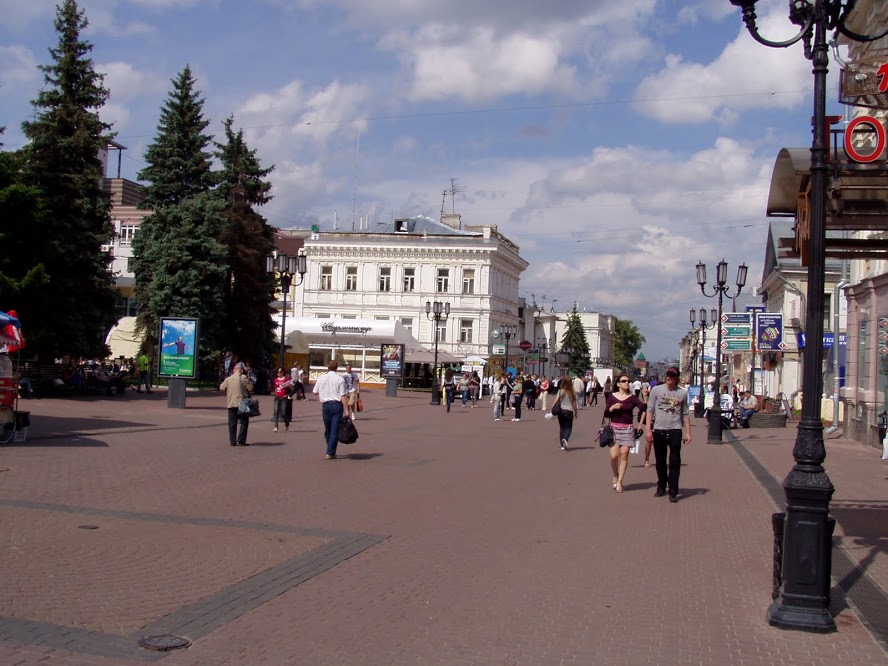 Historic Bolshaya Pokrovskaya Street
Historic Bolshaya Pokrovskaya Street
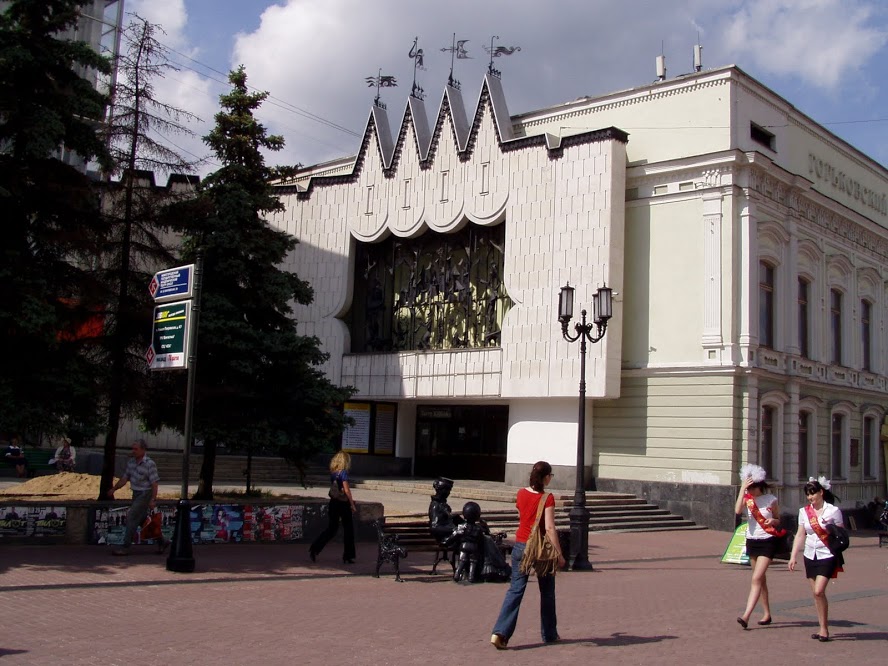 Historic Bolshaya Pokrovskaya Street
Historic Bolshaya Pokrovskaya Street
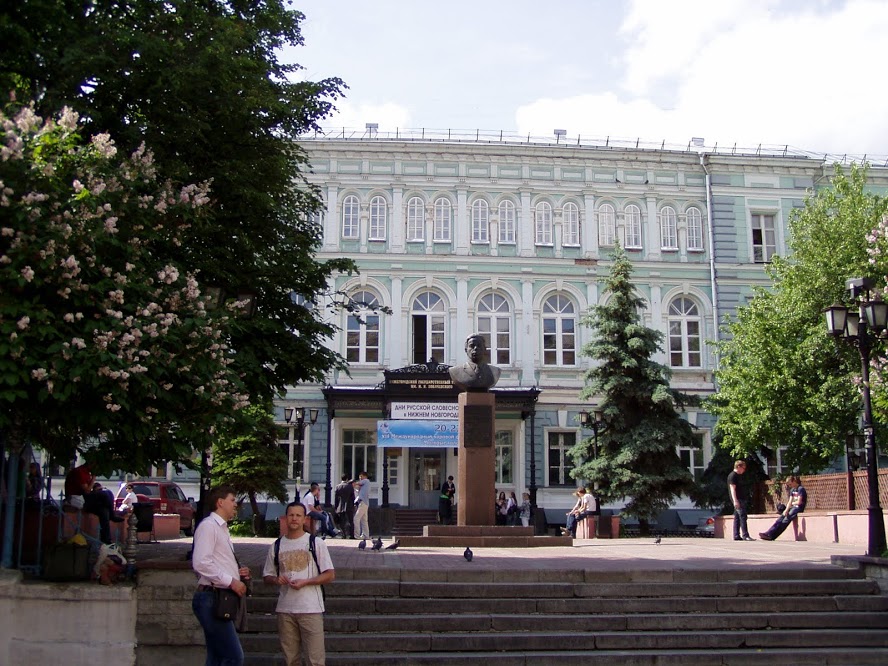 Lobachevsky State University of Nizhny Novgorod
Lobachevsky State University of Nizhny Novgorod
The University of Nizhni Novgorod (UNN) was established in 1916. In 1918 UNN became the first State University of Soviet Russia. In 1956 the university was named after the great Russian mathematician Nikolai Lobachevsky.
Lobachevsky State University of Nizhni Novgorod is one of the leading universities of Russia and a winner of all largest contests in the field of Russian Higher Education. In 2009 Russian Government awarded UNN with a prestigious status of National Research University.
UNN is an internationally recognized higher education institution. The university cooperates with the Russian Academy of Sciences, realizes joint scientific & educational programs with leading foreign universities and research centers from over 25 countries of the world.
Over 32 000 undergraduate/graduate students, 1000 Ph.D. students, and over 600 foreign students from 70 countries (Europe, Asia, Africa, America, CIS countries) study at UNN.
http://www.topuniversities.com/universities/lobachevsky-state-university-nizhni-novgorod/undergrad
“The Bank was designed by Academician Vladimir Pokrovsky and built in 1913 to celebrate the 300th anniversary of the Romanov s dynasty.”Quote from: https://www.flickr.com/photos/99627941@N07/9448567611/
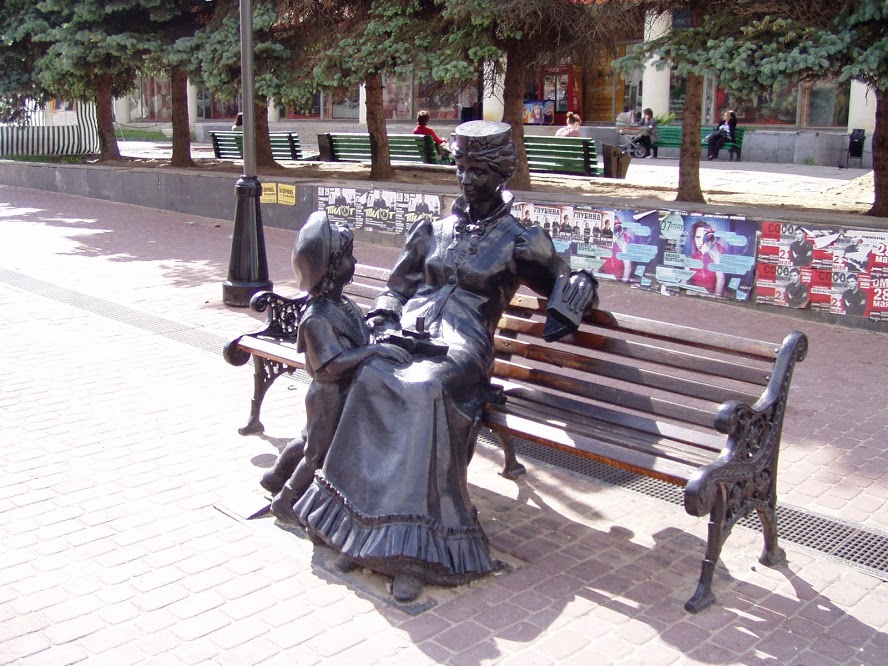 Bronze statues line Bolshaya Pokrovskaya Street.
Bronze statues line Bolshaya Pokrovskaya Street.
http://russianzine.com/nizhny-novgorod-review/
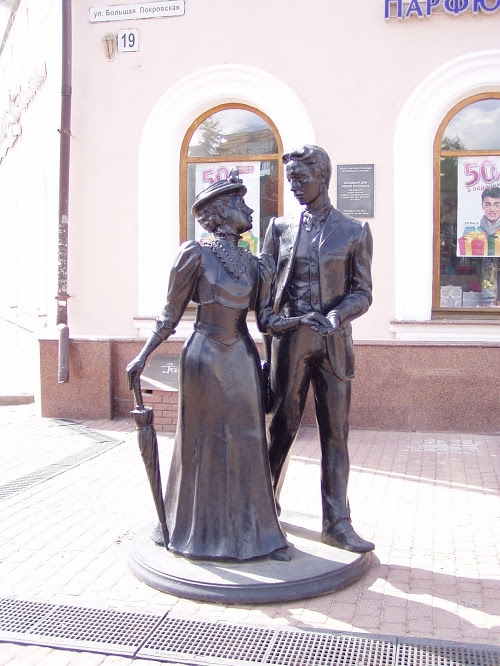 Bronze statue on Bolshaya Pokrovskaya Street
Bronze statue on Bolshaya Pokrovskaya Street
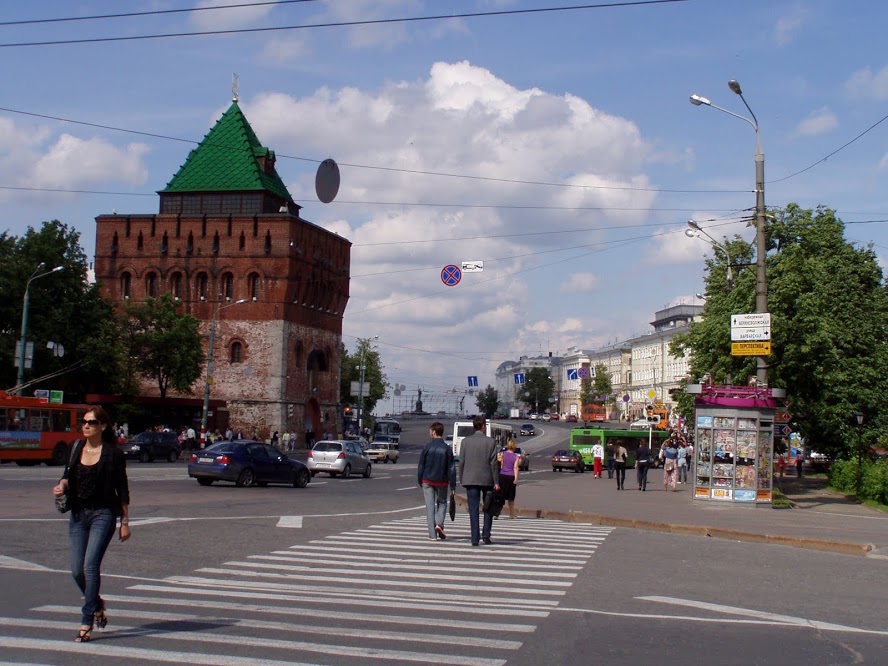 The end of Bolshaya Pokrovskaya Street, which overlooks the Kremlin.
The end of Bolshaya Pokrovskaya Street, which overlooks the Kremlin.
Fantastika is a combination shopping mall and entertainment complex, with bowling alleys, a movie theater, a kid’s zone, and all the usual stores.
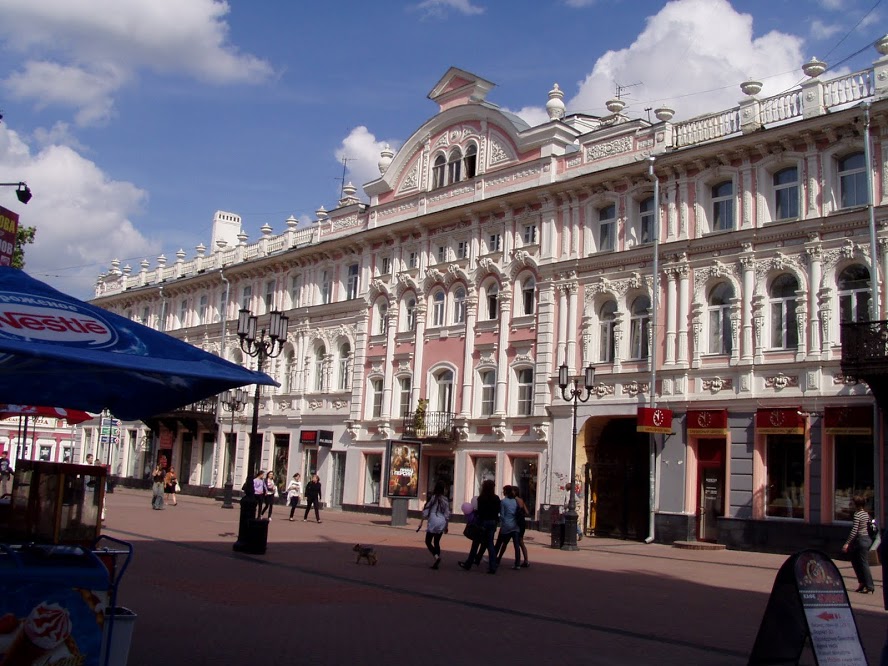 The Yarmarka Train Station – Nizhniy Novgorod/Moscow
The Yarmarka Train Station – Nizhniy Novgorod/Moscow
| Nizhny Novgorod Synagogue |
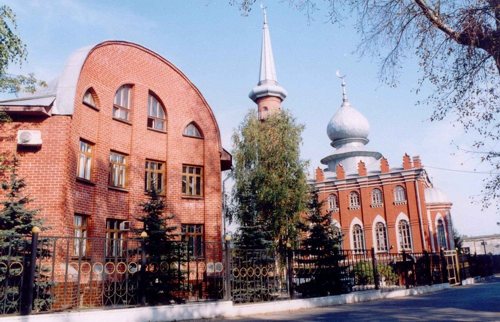 Nizhny Novgorod Cathedral Mosque
Nizhny Novgorod Cathedral Mosque
http://commons.wikimedia.org/wiki/File:Nizhny_Novgorod_Cathedral_Mosque.jpg “For several centuries Islam has been one of the most widespread religions in the Nizhny Novgorod region. First Muslims came here back in the 10th century having inherited Islam from the state of Volga Bulgaria. In the 15–16th centuries Muslim Tatars founded first settlements on the territory of today Nizhny Novgorod area.” http://www.islamrf.ru/eng/news/eheritage/emuslims/6606/
VLADIMER
The City of Vladimir is one of the oldest Russian communities. It is located in the heart of the historic Vladimir region (Vladimirskaya Oblast) 180 kilometers (115 miles) northeast of Moscow on the bank of the Klyazma River. The city was founded in either 990 or 1108, depending on which historians you consult. For the better part of two centuries (from 1157 to the mid 1300s) it was the capital of ancient Rus. Vladimir is now considered one of the major members of the Golden Ring of communities which have played a significant role in Russian history. (http://www.vladimir-russia.info/)
http://www.vladimir-russia.info/photo_gallery/assump_cathedral.htm
http://www.vladimir-russia.info/photo_gallery/landscape.htm
http://www.vladimir-russia.info/photo_gallery/people.htm
http://www.vladimir-russia.info/photo_gallery/people.htm
“All happy families resemble one another, each unhappy family is unhappy in its own way.”
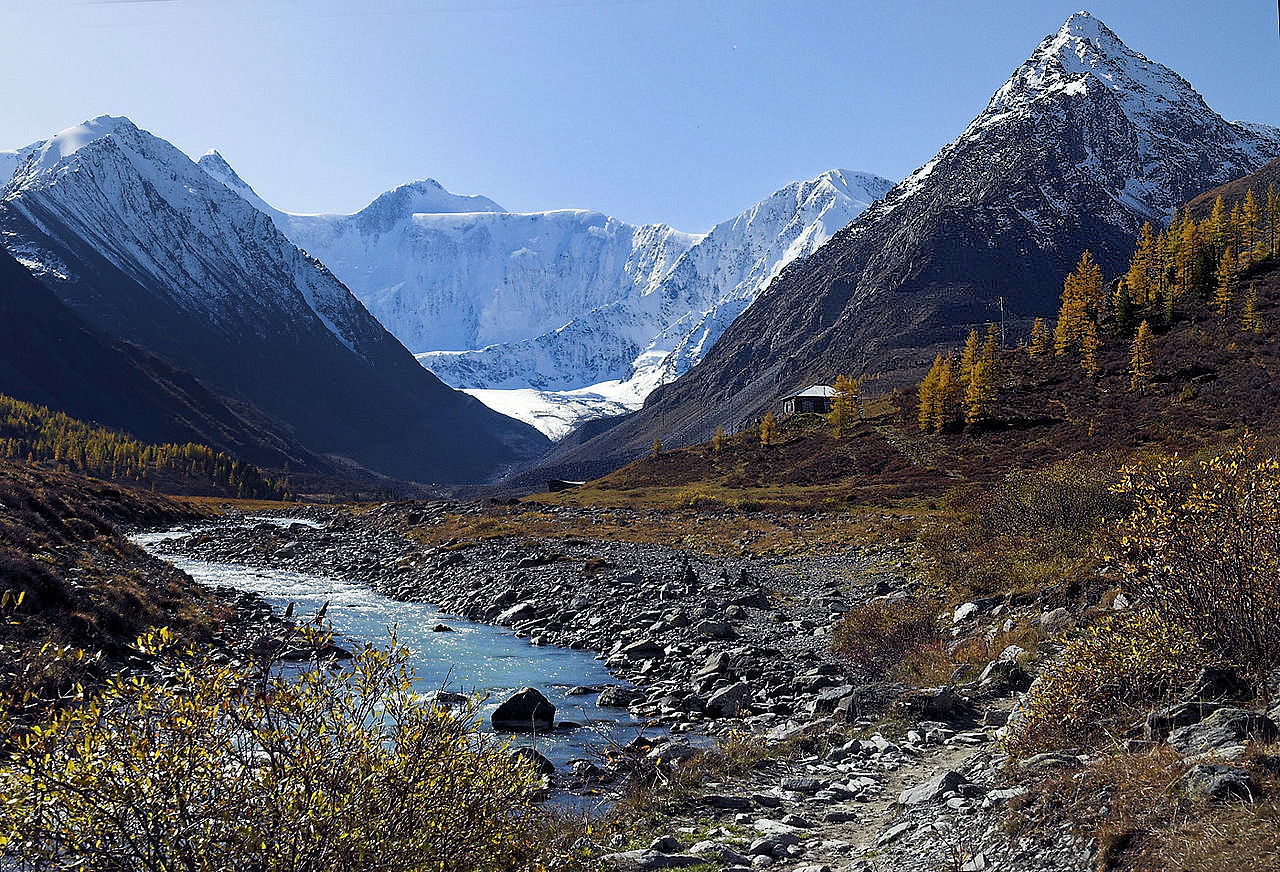 Far East among the boundless Asian space, in the middle of this widest continent, from the infinite Siberian wilderness – raises one of the most captivating mountains in on the Earth – Altai. Vast forests, turbulent rivers, mirror surfaced lakes, snow-capped peaks and amongst them the highest one – Belukha, sparkling masses of ice and vertical rocky walls.
Far East among the boundless Asian space, in the middle of this widest continent, from the infinite Siberian wilderness – raises one of the most captivating mountains in on the Earth – Altai. Vast forests, turbulent rivers, mirror surfaced lakes, snow-capped peaks and amongst them the highest one – Belukha, sparkling masses of ice and vertical rocky walls.
http://www.penguintravel.com/Offer/GuidedWalks/19/Altai-intheTempleofthepurenatureRussia.html
RUSSIA HAS IT ALL!
Russia is the world’s biggest country with its vast territory that occupies the east of Europe and the north of Asia, i.e. 11.46% of the Earth’s land area. Russia is washed by the waters of twelve seas and three oceans: the Arctic in the north, the Atlantic in the west and the Pacific in the east. The country has thousands of rivers and about 2 million lakes, among which are the Caspian Sea, the biggest lake in the world, and Baikal, the world’s deepest fresh-water lake.
http://torussia.org/russia_in_brief
A Toast to Russia – To Russia With Love!







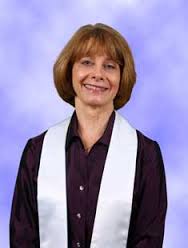
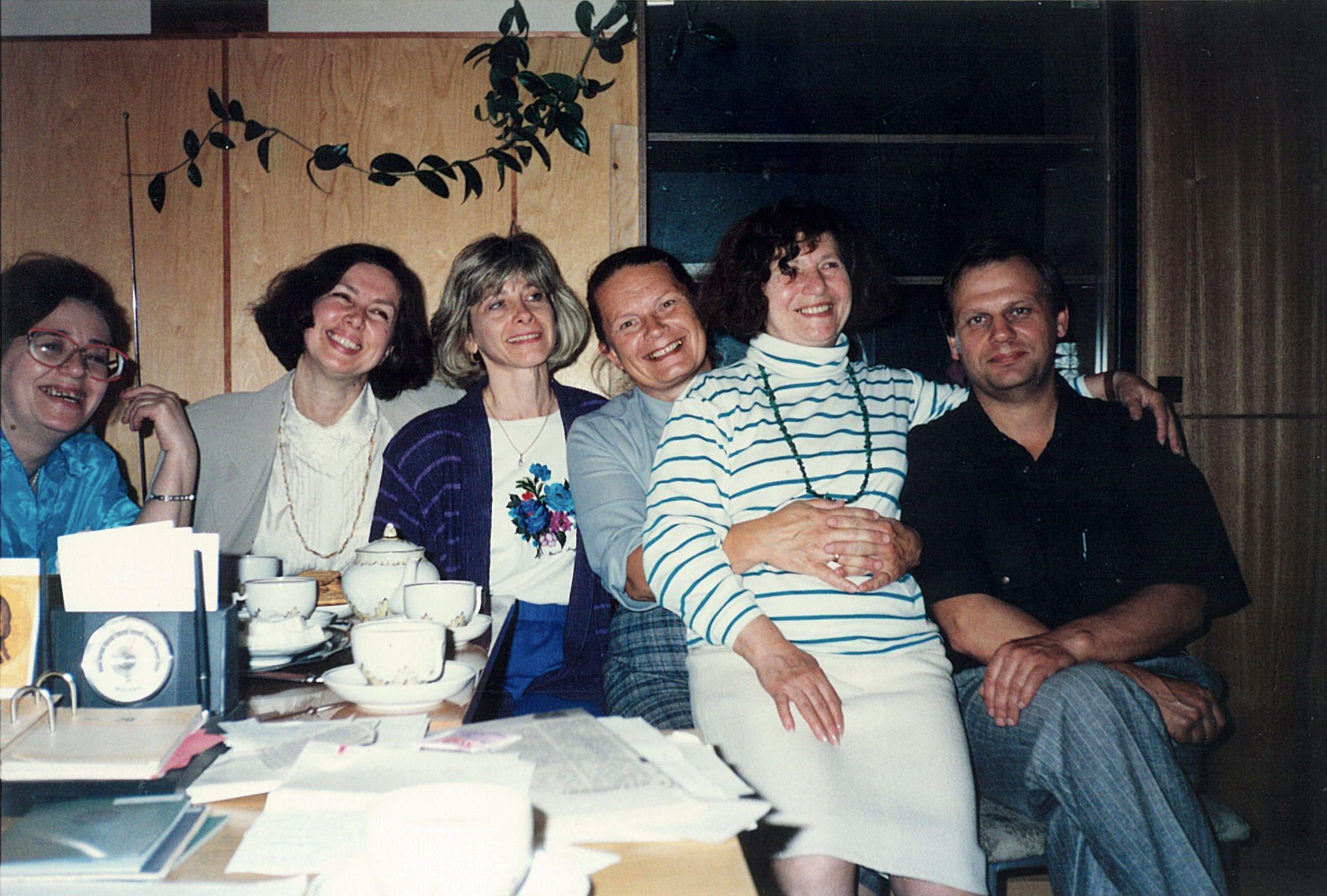
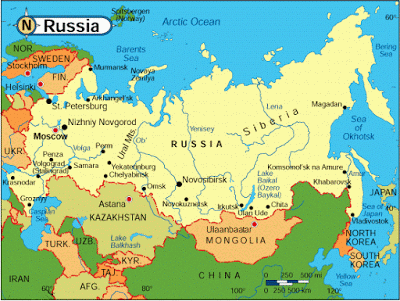
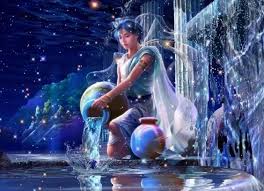
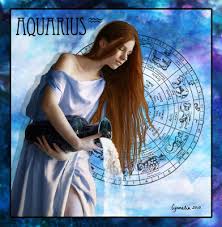
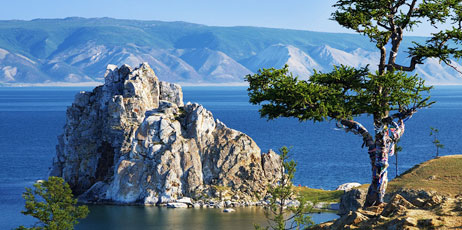
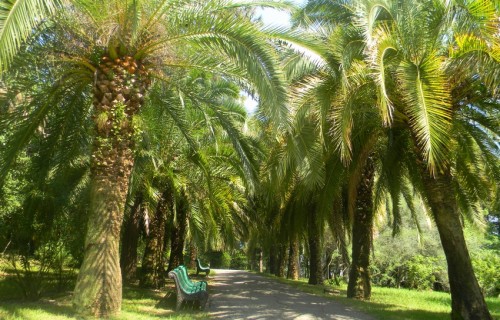
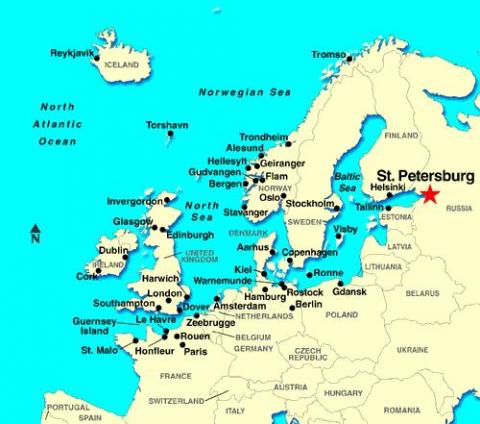
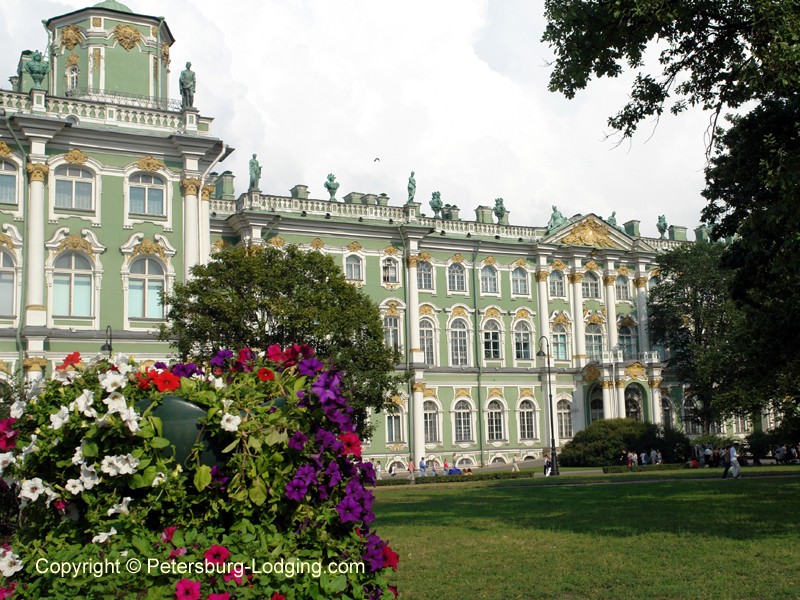
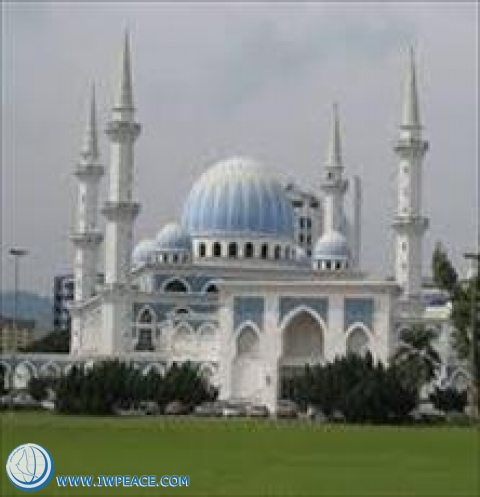
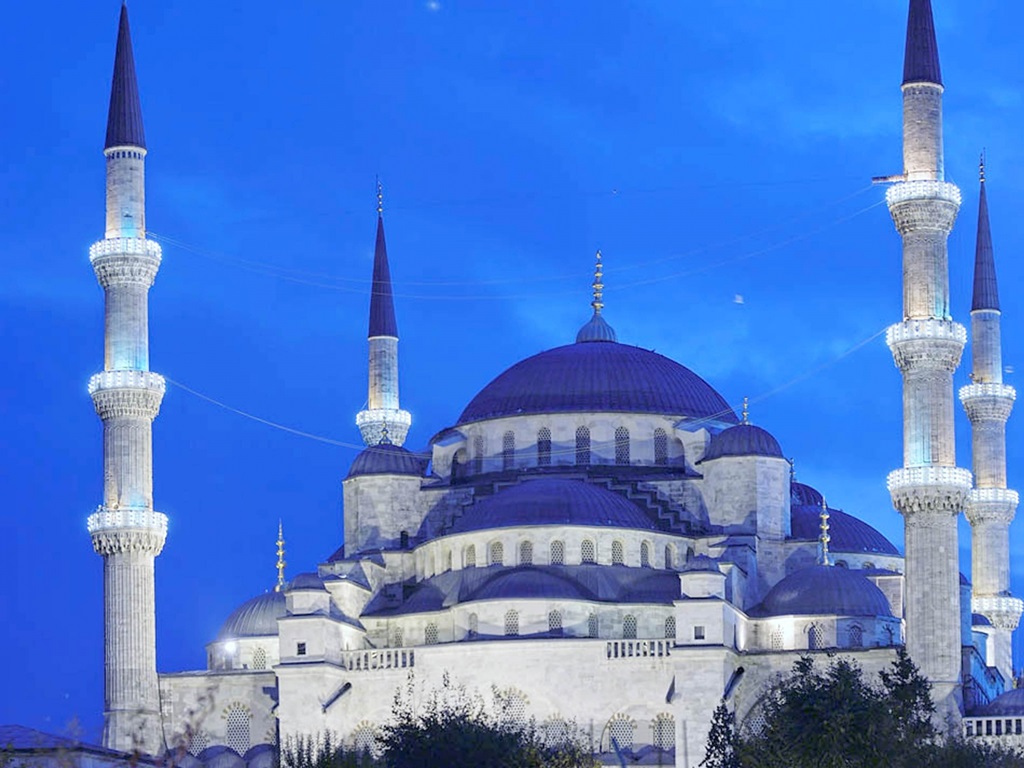
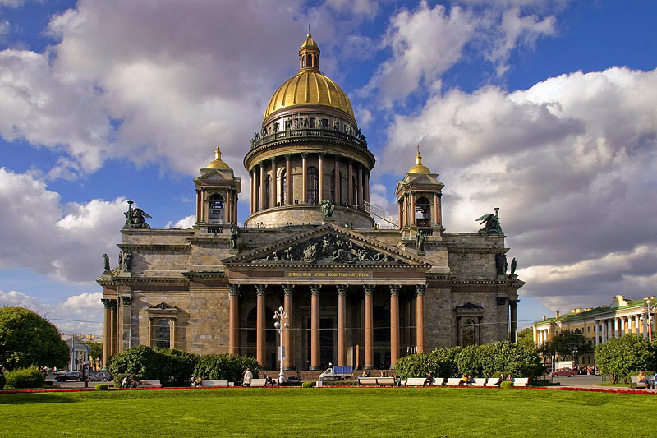
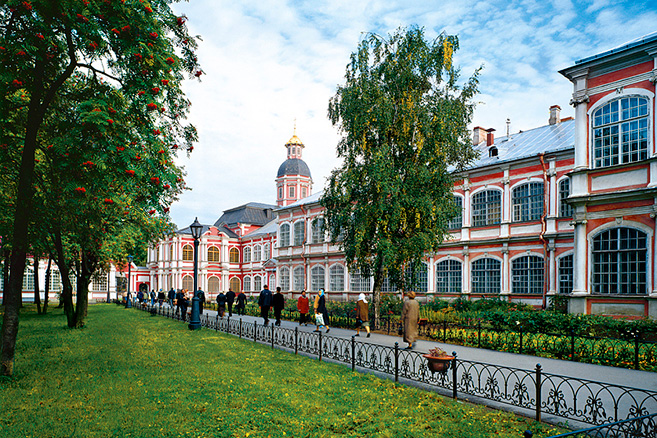
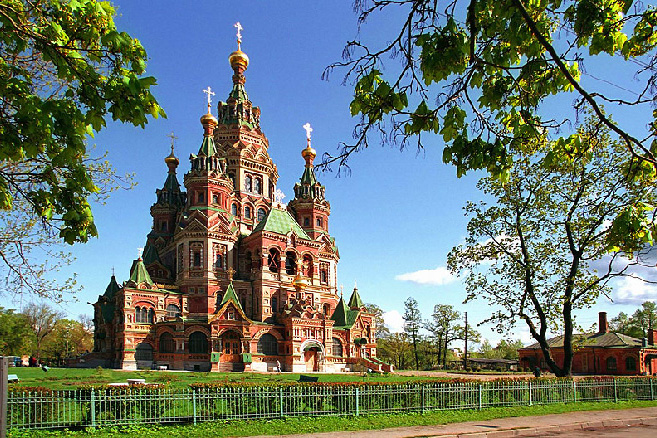 Saints Peter & Paul Cathedral
Saints Peter & Paul Cathedral